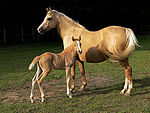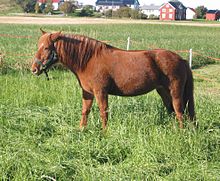- Nordlandshest/Lyngshest
-
Nordlandshest
LyngshestAlternative names Lyngshest, Northlands pony Country of origin Norway Horse (Equus ferus caballus) Nordlandshest/Lyngshest also known as the "Northlands horse" or "Northlands pony", is the smallest of the three Norwegian national horse breeds. Translated to English, the name could be interpreted to be "horse from Nordland/Lyngen". The breed known today originated in Lyngen, but was given the name Nordlandshest in 1968 by breeders in that area of the country. A compromise was later reached as the name change was hotly disputed by breeders in Lyngen and surrounding areas, and today the official name of the breed is both Nordlandshest and Lyngshest.
The Nordlandshest/Lyngshest is a very old breed. They were used by the Vikings, were a main part of the breeding stock that made up the Icelandic horse, and still share many similarities. They may be a descendant of the Asiatic Wild Horse and the Tarpan, from which the Baltic pony or Konik, and the Shetland pony and Exmoor pony also derived.
The Nordlandshest/Lyngshest was a working horse, used for all kinds of work needed on the small farms of Northern Norway. These horses were rarely kept indoors in stables and had to find their own food. The Nordlandshest/Lyngshest breed was almost extinct after World War II. There were only about 15-20 left, mostly older mares, and only one stud; Rimfakse, who all Nordlandshest/Lyngshest today are descended from.
Fortunately the breed was saved, much thanks to the efforts of people like Christian Klefstad. He laboured intensely to bring the breed back, traveling all over northern Norway to gather fertile horses for breeding. Today about 3000 horses are registered, and about 200 foals are born every year.
The breed is quickly gaining popularity today as more and more people discover its many good qualities. The main strength of the breed is that it is a great all-around horse. Today’s Nordlandshest/Lyngshest is a good horse for all equestrian disciplines, from show-jump and dressage to pony trot racing as well as light farm work. It is well suited as a beginner’s and family horse due to its calm temper. It is also renowned for its ability to get by in rough and rugged terrain.
Appearance
A Nordlandshest/Lyngshest is usually slightly larger than an Icelandic horse, standing between 12 to 14 hands (48 to 56 inches, 122 to 142 cm) tall. The body is rectangular, with well muscled back and lend. It is robust, yet light of build, with strong hooves. The breed comes in many colours, and all but dun and blue-eyed white are accepted (dun is the color of the Norwegian fjord horse breed). Large white markings are discouraged.
See also
External links
Equine Equine science and
management
Equestrianism
and sportGlossary of equestrian terms · List of Equestrian Sports · Horse tack · Bit · Bridle · Saddle · Harness · English riding · Western riding · Driving · Horse training · Horse racing · Equestrian at the Summer Olympics (medalists, venues) · Horse show · EquitationEvolution and history Domestication · In warfare · In the Middle Ages · Horses in East Asian warfare · History of the horse in South Asia · Horses in the Napoleonic Wars · Horses in World War I · Horses in World War II · History of the horse in BritainHorse breeds, types
and other EquidaeList of horse breeds · Wild horse · Feral horse · Stock horse · Gaited horse · Draft horse · Warmblood · Sport horse · List of horse breeds in DAD-ISOther EquusHybridsCategories:- Horse breeds
- Culture in Nordland
- Natural history of Norway
- Horse breeds originating in Norway
- Horse stubs
- Norway stubs
Wikimedia Foundation. 2010.

